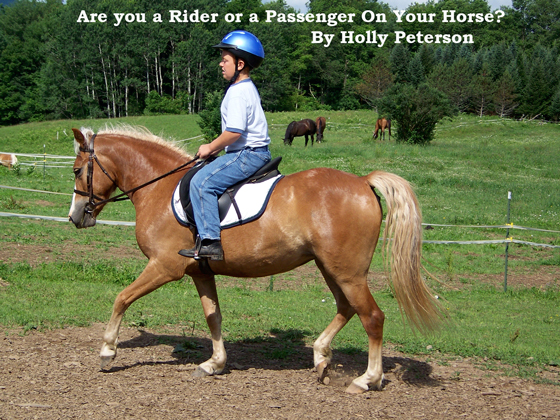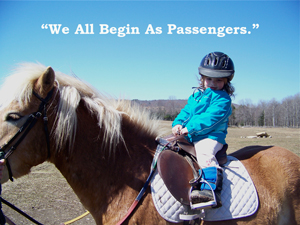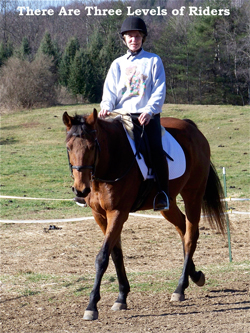Are you a Rider or a Passenger On Your Horse?
By Holly Peterson

There are many levels of riding but they really come down to just two categories- Riders and Passengers.
What are passengers? A passenger is defined in the dictionary as; a traveler on public or private conveyance but is not the driver, or pilot. When applying this definition to riding, the horse is obviously the conveyance, but you need to ask yourself: Are you the pilot or the traveler? Just because you rode your horse from point A to point B doesn’t mean you put him there, it could just mean you bought the ticket.
Passenger riders are just what they sound like, someone who sits there while the horse does most of the work. While they may be able to control the horse's gaits and even jump; they are often not soft or effective in their aids, are using only the most basic of aids, or don’t know how their body affects their horse, and are not always knowledgeable about how the horse moves.
The Passenger Rider has six levels.
 1. Beginner.
1. Beginner.
The beginner is just that, a beginner. They have no experience with horses at all and need to learn everything from the ground up. Their first few rides are basically glorified pony rides and they learn the basics of stop, start, steer and proper position.
2. Novice
The novice passenger is still in the beginning stages of riding and still technically a beginner, just a bit more advanced. They have a little more control but still require a lot of guidance in the ‘how to’. They are learning how to balance on the horse, are able to walk on their own, halt, and starting to trot. They are learning to post thier diagonals, continuing to work on position, and are starting to work on figures such as circles as well as changes of direction.
3. Intermediate
The intermediate passenger is able to comfortably walk and trot, they are also beginning to learn to canter. They require slightly less guidance for simple things. They are starting to self-correct diagonals and are able to ride longer on their own. They have decent control of the horse, are able to confidently change direction, circle and are starting to do patterns such as serpentines. Many intermediate riders will also begin trotting poles and/or small jumps at this point.
4. Advanced
The advanced passenger is able to walk, trot, canter and most likely will be able to jump. They require less guidance than the intermediate rider for the simple things. They have good control over the horse and are able to circle, change direction, perform figures and patterns in all gaits; learning simple and flying changes, in addition to jumping courses.
5. Active
The active passenger is in the advanced stages, is competently schooling and can control the made horse.
This rider is actively working to put the horse into a frame but may not always be working with the horse. Their use of aids starts with the hands and legs.
6. Passive Passenger
The Passive passenger is also in the advanced stages, is competently schooling, and has good control of made horses. They are learning to move with the horse and while they generally don’t interfere with the horse's movement they do little to help his way of going. They are more the ‘go with the flow’ type rider.
*Please note that to this point I am using the word ‘control’ not guidance.
Every barn has their own version of these levels but they don't generally differentiate the rider and passenger.
So, what is a Rider? A Rider is defined in the dictionary as; a person who rides horses. However riders, real riders, are so much more than that. Riders are advanced passengers that have moved beyond just balancing themselves on their horse. They have moved towards bringing their horse into stability and ultimately being balanced, they become supple and light together; using not only their hands and legs but all their natural aids. The application and use of aids has advanced from kick-to-go and direct rein aids, to the use of all five natural aids in order to influence the performance of their horse. Riders are also able to competently handle a less made horse.
There are only 3 levels of Rider. 
1. Novice
The Novice Rider is an Intermediate or Advanced Passenger who is learning to communicate with their horse using more than just hands and legs to produce a specific result. They are learning not only how the horse moves but how to use their own body to affect their horse's movement. They are moving towards being in balance with their horse.
2. Intermediate Rider
The Intermediate Rider has a firm understanding of the horse's movement and rhythm and is fairly consistent using their aids. They demonstrate consistency with all levels and gaits.
3. Advanced Rider
The Advanced Rider is in tune with their horse when they ride. Every nuance, weight change and leg aid, are perfectly timed to influence the motion and rhythm of the horse; creating seemingly effortless results.
The major difference between Riders and Passengers is their communication with the horse. Actually Intermediate and Advanced Passengers can also be Novice Riders. This all depends on the lesson program they are in. Some barns just don’t teach beyond the Passenger basics. Some do. Those that do teach students from the beginning how a horse moves in each gait; how many beats, how the legs move, what that does to the horses back, how the movement affects the rider and that’s just the beginning.
Don’t get me wrong, there is a place for the Passenger Rider. The fact is we all start out as Passengers. It Doesn't matter whether it was a pony ride at the fair, on your friend's pony in their back-yard, or with an instructor in your first lesson, you got on and sat there. You were most likely led around and told “pull to stop, kick to go, pull left to go left, pull right to go right”.
Beginners stay passengers for a long time. This is not a bad thing, because they are learning. We all had to start somewhere and learning to ride at a basic level on a school horse is where we all start; where we should start. I don’t know a single rider who ever got on for the first time was completely balanced, had their horse in balance and just ‘knew’ what to do.
At some point though don’t we need to move past being a Passenger and start working towards becoming a Rider, even at a basic level? To work towards a better communication between horse and rider that extends beyond the kick and pull.
There are a lot of Advanced Passengers out there that don’t know they are Passengers. Are they talented: Absolutely. But, there is so much more to the ride than a fixed position and stiff hands.
So, what did you decide? Are you the pilot or did you just buy the ticket? Which would you rather be? The nice thing about horses - it’s never too late to learn.


